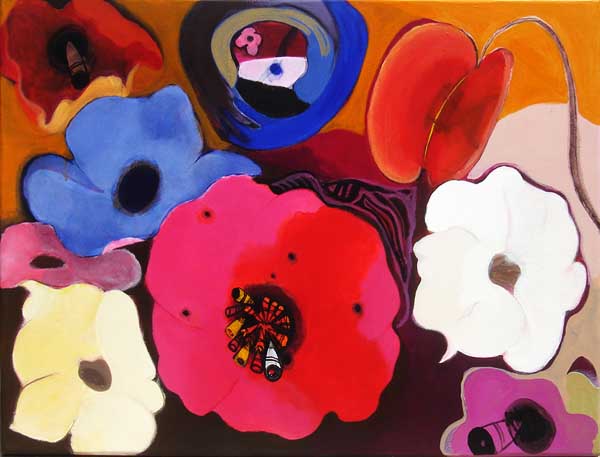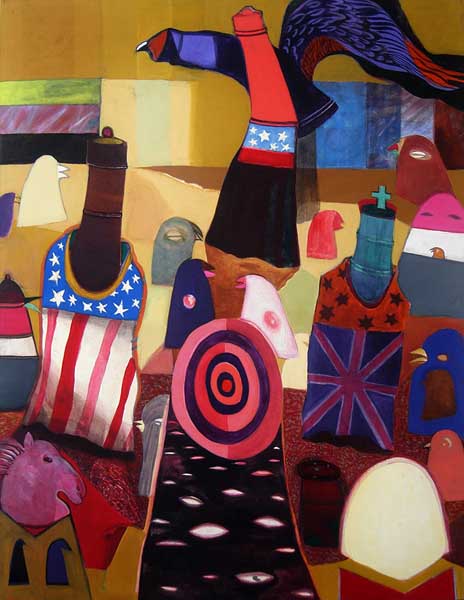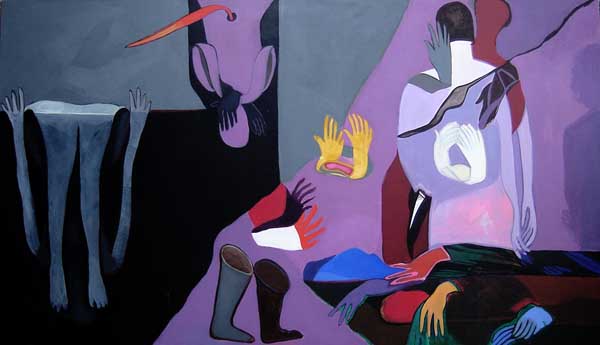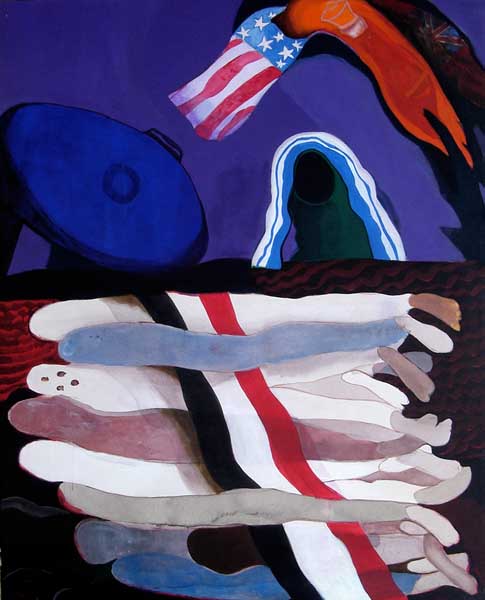by Rahnuma Ahmed

Flowers blossom, but with bullets in place of stigma. Bullets signal the end of fertility, the end of life. They signal death and destruction (After the end of time – 3).

A chess board. The king wears Stars and Stripes, his minister is dressed in the Union Jack. Soldiers litter the board, two have holes in their hearts. The path to a target practising board is strewn with eyes, un-seeing eyes. Dead targets. One eye, may be half-alive, stares at us unblinkingly. An eagle, hovering above, stops in its flight of extending the empire, to oversee American-style democracy take root in a faraway land (Before the end of time – 2). This is how Bangladeshi artist Dilara Begum Jolly captures the present moment on her canvas.

Bodies fractured by wars of the present, dismembered limbs, single hands — coloured red, yellow, blue, purple — lie lifeless. Others are raised upwards, they seem to be imploring. Stop this madness, stop the war. A human body folded, her head and pair of legs buried beneath the soil, her arms too. The trunk of her body and her fingers are visible. Fingertips stretched outward, towards the sun, towards light. A flaming red petal of a bird of paradise springs forth like a knife from the navel of a human body as she lies face upwards, her hands tied in a knot. A pair of army boots remind us of how it happened (Before the end of time – 4).

An Iraqi flag interweaves between dead bodies lying in a heap. Mother Teresa grieves silently as a furious red hand, gloved in Stars and Stripes, hangs over — and above — everything else. Once again, a Union Jack, this time in the background (Before the end of time – 1).
Other canvases, other images. Naked bodies, imprisoned bodies heaped on each other, surveilled by an eagle eye, the new owners of Abu Ghuraib. Autumn leaves falling on a white background as women, dressed in hijab, some in brown, others in purple, or blue, grey, white, stand shoulder to shoulder to the right of the canvas. They seem to be grieving. May be for a lost husband or a daughter. May be a son, a grandmother or a lover. For people, obscured by words spun by the invader — safe and secure in Pentagon, Washington, Fort Benning, and Downing Street — “collateral damage.” May be for the loss of national independence and freedom.
Other canvases, other images. Not any civilisation, but the cradle of civilisation itself destroyed. Army vehicles advancing on monuments. Statues and sculptures lying scattered as blank pages of history waft down. A Buddha head looks impassively as a shot is fired into its right eye. A broken cuneiform tablet.
And yet, in the midst of all the death, destruction and havoc, a pink lotus blooms. And that, as we who are familiar with the artist’s work know, is Dilara Begum Jolly’s signature. A flower, a sapling, a shoot springing forth in the midst of ruins. Signalling life, its force and energy. Its beauty. Signalling the will to live. The death of forces of evil.
Dilara Begum, known more by her nickname Jolly than her proper name, has always produced art that is social, and political. That is keenly critical of the prevailing order, whether at home or abroad. Or, as her exhibition Excavating Time (Bengal Gallery of Fine Arts, 4 – 17 September 2006) shows, of the new order that has not only destroyed the cradle of civilisation, but threatens to destroy all vestiges of life on the planet. An inexorable war machine, spinning lies and deceit to the heavy rounds of applause by western politicians, generals, defence analysts and journalists.

Other canvases in the exhibition drew on the womb, on foetuses, on the pain of giving birth. Or, of not giving birth, of an embryo that retreats into the womb, repelled by the patriarchal order that controls and regulates life outside (Embryo withdrawn – 1).
Jolly’s more recent work draws on the the nokshi kantha (quilt-making) tradition of Bangladeshi women, quilts that are made from worn-out saris, two to three sewn together, richly embroidered from folk tales, myths, everyday artefacts, and daily village life as seen by, and as intrepreted by, women. Always. Instead of strokes and brushes, Jolly paints short stitches that weave tales, of women as mothers, as sisters, and as friends, drawing on traditions of weaving to tell stories of the pain and wonderment of giving birth. Of creating, and re-creating, bonds of solidarity.





Leave a Reply
You must be logged in to post a comment.